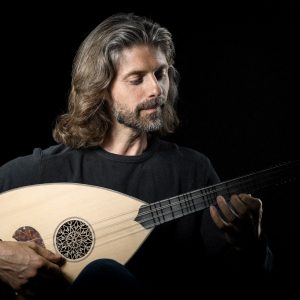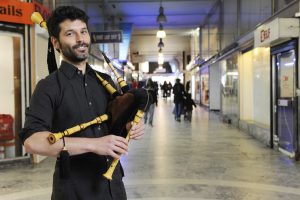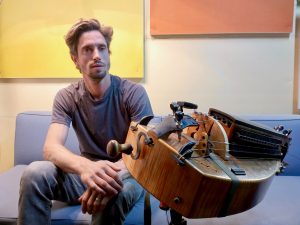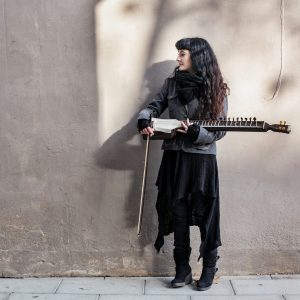Toasaves is a Belgian music collective with a fascination for archaic Flemish folk songs and their relationship to early music and Eastern music. Toasaves is written phonetically and means “home ports” in the Antwerp dialect. The band, founded in early 2021 by oud player and artistic director Tristan Driessens, brings together nine musicians from Belgium, France, Netherlands, Spain and Cyprus, each with a broad artistic background and expertise.
The Toasaves’ exceptionally rich and rare set of instruments fulfills a connecting function. Thanks to virtuoso performances on traditional instruments from East and West – medieval flutes, drums, cisterns and fiddles, Oriental violin, Turkish lutes (lavta and oud) and frame drums (daf, bendir, pandero cuadrado), hurdy-gurdy, Flemish and Irish bagpipes, Indian dilruba and bansuri, Afghan rebab, Persian santur, etc. – new light is shed on the actual source of musical traditions that, separated in time and space, often contain the same poetic and musical secrets.
Starting from the folk repertoire of Wannes van de Velde, the travelling companions surprise us by mixing it with early music, traditional dance music from the Greek islands, classical court music (makam) from Istanbul and even folk music from Afghanistan.
Their first album Zwerver was awarded “Best Album” at Flanders Folk Awards 2024.
The musicians :
- Tristan Driessens – lutes, concept, arrangments, artistic direction (BE)
- Raphaël De Cock – vocals, bagpipes, Jew’s harp (BE)
- Harald Bauweraerts – hurdy-gurdy (BE)
- Miriam Encinas – vielle, dilruba, medieval flutes, frame drums (ES)
More to discover over here.
 “With a lot of creativity, openness, and using all the human affinities within the group, we can do some really fabulous things” (Tristan) Tristan Driessens discovered the ûd (oriental lute) through Sephardic and Arab-Andalusian music. From 2009 to 2012, he stayed in Istanbul to improve with his master Necati Çelik. Back in Belgium, he obtained a master’s degree in Turkish ûd at the LUCA School of Arts and in Musicology at the Université Libre de Bruxelles. Today, he is recognized in Belgium as one of the main references in ûd and Turkish classical music (makam). He collaborates with Tcha Limberger, Derya Türkan, Kudsi Erguner and Emre Gültekin, and he is the artistic director of Ensemble Lâmekân and Refugees for Refugees. His other projects are Tristan Driessen’s Soolmaan Quintet, Seyir Trio, La Compagnie d’Elias.
“With a lot of creativity, openness, and using all the human affinities within the group, we can do some really fabulous things” (Tristan) Tristan Driessens discovered the ûd (oriental lute) through Sephardic and Arab-Andalusian music. From 2009 to 2012, he stayed in Istanbul to improve with his master Necati Çelik. Back in Belgium, he obtained a master’s degree in Turkish ûd at the LUCA School of Arts and in Musicology at the Université Libre de Bruxelles. Today, he is recognized in Belgium as one of the main references in ûd and Turkish classical music (makam). He collaborates with Tcha Limberger, Derya Türkan, Kudsi Erguner and Emre Gültekin, and he is the artistic director of Ensemble Lâmekân and Refugees for Refugees. His other projects are Tristan Driessen’s Soolmaan Quintet, Seyir Trio, La Compagnie d’Elias.
 Harald Bauweraerts is a musical jack of all trades. In addition to playing the electro-acoustic hurdy-gurdy, he is enthusiastic about all sorts of analog synthesizers, effects, percussions and sequencers. Harald strives to achieve a beautiful and harmonious symbiosis between the analog and numeric world, between acoustic and electronic, and between light and dark. Through the ages, from one culture to another.
Harald Bauweraerts is a musical jack of all trades. In addition to playing the electro-acoustic hurdy-gurdy, he is enthusiastic about all sorts of analog synthesizers, effects, percussions and sequencers. Harald strives to achieve a beautiful and harmonious symbiosis between the analog and numeric world, between acoustic and electronic, and between light and dark. Through the ages, from one culture to another. Miriam Encinas grew up in a family of musicians: «Els Trobadors» and «L’Arc en el Cel». Her innate musicality combines the fresh perspective of a performer raised in a traditional music environment with the rigor and precision of her academic training. She studied the recorder with Sara Parés at the Conservatori del Liceu in Barcelona. Later she studied early music with : Pedro Memelsdorff, Christian Curnyn, Pia Elsdorfer, and percussion with Pedro Estevan. In 2001, she began studying Viola de Gamba with Cristian Sala and since 2013 Dilruba and Afghan music with Daud Khan Sadozai. As a professional musician, she is a member and has collaborated with: Evo, Mos Azimans, Via Artis Konsor, Joi de Trobar, l’Ham de Foc, Ensemble l’Albera, …
Miriam Encinas grew up in a family of musicians: «Els Trobadors» and «L’Arc en el Cel». Her innate musicality combines the fresh perspective of a performer raised in a traditional music environment with the rigor and precision of her academic training. She studied the recorder with Sara Parés at the Conservatori del Liceu in Barcelona. Later she studied early music with : Pedro Memelsdorff, Christian Curnyn, Pia Elsdorfer, and percussion with Pedro Estevan. In 2001, she began studying Viola de Gamba with Cristian Sala and since 2013 Dilruba and Afghan music with Daud Khan Sadozai. As a professional musician, she is a member and has collaborated with: Evo, Mos Azimans, Via Artis Konsor, Joi de Trobar, l’Ham de Foc, Ensemble l’Albera, …